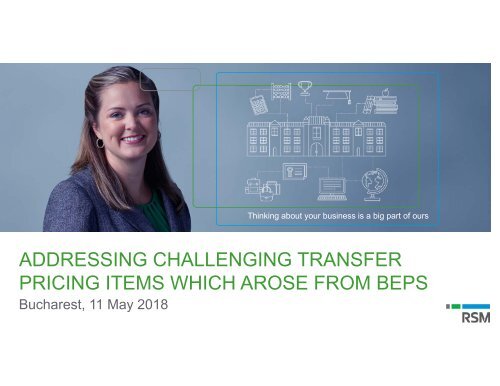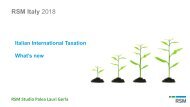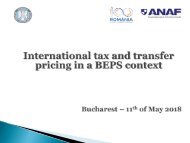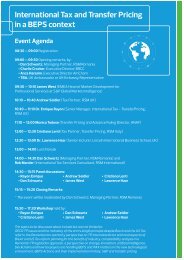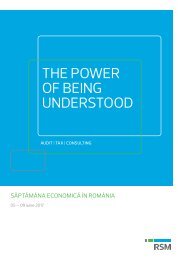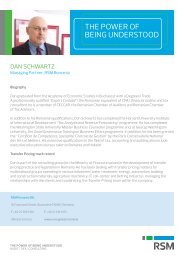3. Addressing Challenging Transfer Pricing Items which Arose from BEPS - Enrique Rayon
You also want an ePaper? Increase the reach of your titles
YUMPU automatically turns print PDFs into web optimized ePapers that Google loves.
Thinking about your business is a big part of ours<br />
ADDRESSING CHALLENGING TRANSFER<br />
PRICING ITEMS WHICH AROSE FROM <strong>BEPS</strong><br />
Bucharest, 11 May 2018<br />
<strong>Transfer</strong> <strong>Pricing</strong> | 2017
Agenda<br />
• Introduction<br />
• <strong>Transfer</strong> <strong>Pricing</strong> Documentation<br />
• Value Chain Analysis<br />
• Profit Split<br />
• A note on Comparability post-Brexit or U.S. Tariffs<br />
<strong>Transfer</strong> <strong>Pricing</strong> | 2017
Introduction<br />
• “The <strong>BEPS</strong> project put meat on the bones of the arm’s length principle.”<br />
Pascal Saint-Amans, Director, OECD Centre for Tax Policy and<br />
Administration (Bloomberg BNA, <strong>Transfer</strong> <strong>Pricing</strong> Report, October<br />
15, 2015)<br />
• “<strong>BEPS</strong> project’s primary objective is to ensure that profits are reported<br />
for tax purposes where economic activities are carried out and where<br />
value is created.”<br />
Raffaele Russo, Head of the OECD/G20 <strong>BEPS</strong> project group<br />
<strong>Transfer</strong> <strong>Pricing</strong> | 2017
Introduction<br />
Typical Allocation of<br />
Economic Returns<br />
Routine<br />
Distribution<br />
Routine<br />
Manufacturing<br />
Intangibles<br />
<strong>Transfer</strong> <strong>Pricing</strong> | 2017
<strong>Transfer</strong> <strong>Pricing</strong> Documentation<br />
• OECD <strong>BEPS</strong> Action 13, 2015 Final Report “<strong>Transfer</strong> <strong>Pricing</strong> Documentation and<br />
Country-by-Country Reporting”<br />
• i.e., <strong>Transfer</strong> <strong>Pricing</strong> Documentation under the TPGs’ new Chapter V<br />
• Three tiers<br />
– Master file<br />
– Local file<br />
– Country-by-Country Report<br />
• Many countries’ TP documentation regulations have implemented MF and LF<br />
requirements (e.g., CN, MX, NL, etc.) while others have not changed or do not<br />
require a MF and LF (e.g., U.S., U.K., RO, CA, etc.)<br />
<strong>Transfer</strong> <strong>Pricing</strong> | 2017
Value Chain Analysis<br />
• The arm’s length principle and value creation, not formulary apportionment<br />
• Value Creation ≠ Value Chain Analysis<br />
• Selected countries require a value chain analysis is to be included in transfer<br />
pricing documentation, e.g., CN, NL, etc.<br />
• How and where is value created in the company?<br />
• VCA ≈ Art+Science<br />
• Delineate the intercompany transaction<br />
• Functional analysis (functions, risks, assets)<br />
• Economic Value of functions/risks/assets, again, not a formulary profit allocation<br />
<strong>Transfer</strong> <strong>Pricing</strong> | 2017
Value Chain Analysis<br />
Conventional Supply Chain<br />
Manufacturing<br />
Co.<br />
(Country A)<br />
Distribution<br />
Co.<br />
(Country B)<br />
Customers<br />
: Sales of Products<br />
<strong>Transfer</strong> <strong>Pricing</strong> | 2017
Value Chain Analysis<br />
A new look at the Supply Chain<br />
Contract R&D<br />
Co.<br />
Shared Services<br />
Co.<br />
Sales Services<br />
Co.<br />
Contract<br />
Manufacturing<br />
Co.<br />
Principal Co.<br />
Customers<br />
Procurement<br />
Co.<br />
Logistics /<br />
Warehousing<br />
Co.<br />
: Sales of Products<br />
: Provision of<br />
Services<br />
<strong>Transfer</strong> <strong>Pricing</strong> | 2017
Profit Split<br />
• Transactional profit split method, OECD TPGs Chapter II, Section C<br />
• The guidance is undergoing revisions as mandated by <strong>BEPS</strong> Action 10 to clarify<br />
the application of the profit split method in the context of global value chains<br />
• The profit split method is not a one-sided method like the TNMM<br />
• It is a two-sided (or more) method, i.e., two or more companies transacting and<br />
making non-routine contributions in the transaction (i.e., integrated transactions<br />
involving IP or high-value services)<br />
• Focus is on the total profit associated with the intercompany transaction<br />
• Allocates a portion of total profits to each entity based on relative functions, risks,<br />
and assets<br />
• May apply when Traditional Transaction Methods do not apply<br />
• It is not a formulary apportionment method<br />
<strong>Transfer</strong> <strong>Pricing</strong> | 2017
Profit Split<br />
π<br />
Typical Allocation of<br />
Economic Returns<br />
Routine<br />
Distribution<br />
Routine<br />
Manufacturing<br />
Intangibles<br />
Routine<br />
Profit<br />
Nonroutine<br />
Profit<br />
(aka:<br />
residual profit)<br />
<strong>Transfer</strong> <strong>Pricing</strong> | 2017
Profit Split<br />
π<br />
Typical Allocation of<br />
Economic Returns<br />
Routine<br />
Distribution<br />
Routine<br />
Manufacturing<br />
Intangibles<br />
Routine<br />
Profit<br />
Nonroutine<br />
Profit<br />
(aka: residual<br />
profit)<br />
Value Creators -----><br />
<strong>Transfer</strong> <strong>Pricing</strong> | 2017<br />
Contribution 1 Contribution 2<br />
Contribution 3
A note on Comparability<br />
• Selection of the most appropriate transfer pricing method to the circumstances of the<br />
case<br />
– Traditional transaction methods<br />
– Transactional profit methods<br />
• Transactional Net Margin Method (TNMM)<br />
– Based on net profit indicators, more tolerant to some functional differences than<br />
gross profit margins<br />
– Product comparability takes (took) less importance than functional comparability<br />
• Comparability of Pan-European benchmarks post-Brexit<br />
• Comparability of non-product-specific benchmarks post-U.S. tariffs<br />
– U.S. distributors<br />
– European and China manufacturers<br />
– China distributors vis-à-vis Pan-Asian distributors<br />
• Impact to the MNEs’ supply chains<br />
<strong>Transfer</strong> <strong>Pricing</strong> | 2017
Thank you for<br />
your attention.<br />
<strong>Transfer</strong> <strong>Pricing</strong> | 2017


